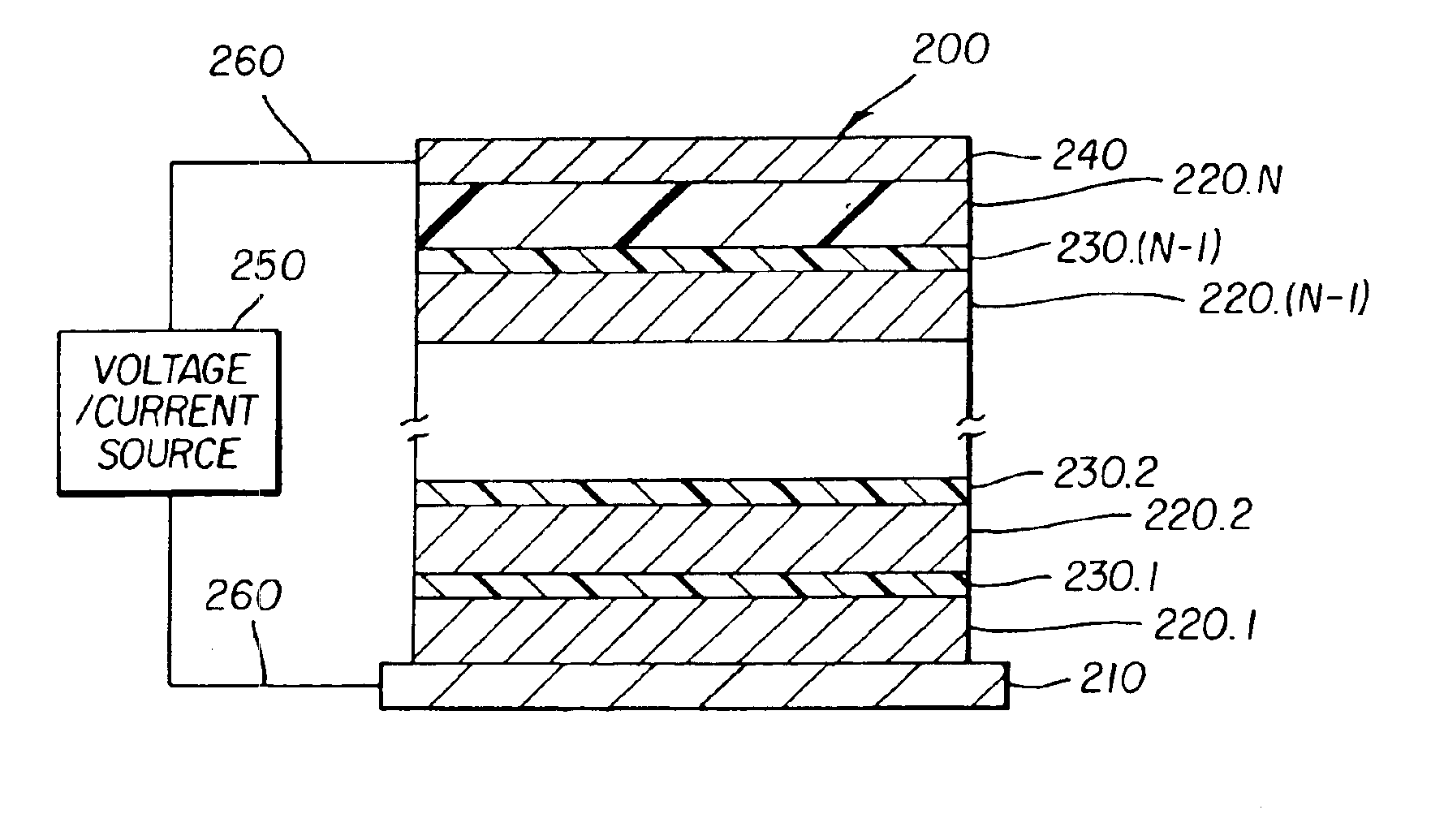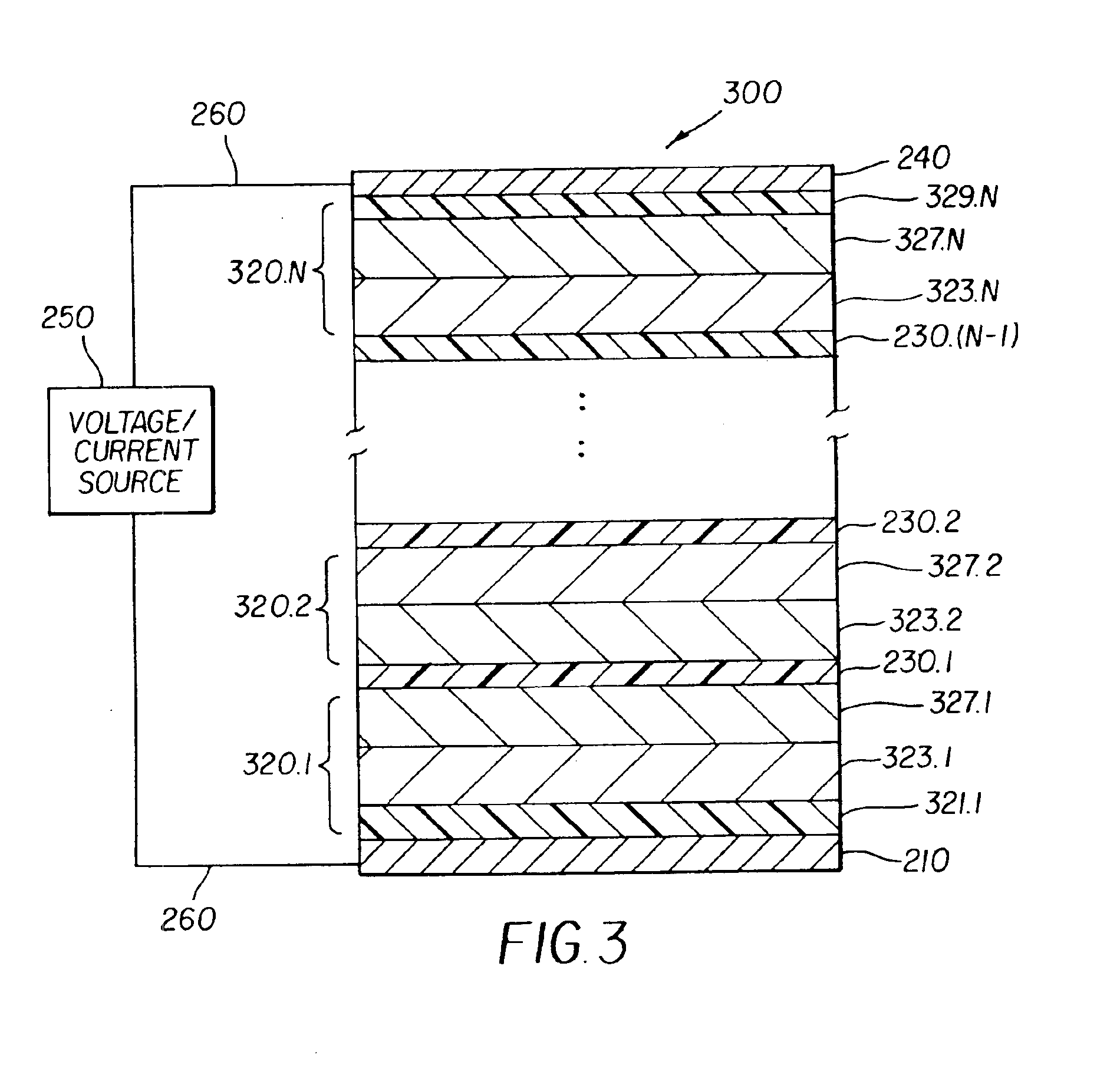Providing an organic electroluminescent device having stacked electroluminescent units
a technology of electroluminescent units and organic materials, which is applied in the direction of discharge tube luminescnet screens, natural mineral layered products, transportation and packaging, etc., can solve the problems of unavoidable trade-off between luminance and operational life, the total current requirements of the device are not reduced, and the luminance efficiency in terms of candela per ampere (cd/a) is actually not improved
- Summary
- Abstract
- Description
- Claims
- Application Information
AI Technical Summary
Benefits of technology
Problems solved by technology
Method used
Image
Examples
example 1
Conventional OLED—Comparative
The preparation of a conventional non-stacked OLED is as follows: A 1 mm thick glass substrate coated with a transparent ITO conductive layer was cleaned and dried using a commercial glass scrubber tool. The thickness of ITO is about 42 nm and the sheet resistance of the ITO is about 68 Ω / square. The ITO surface was subsequently treated with oxidative plasma to condition the surface as an anode. A layer of CFx, 1 nm thick, was deposited on the clean ITO surface as the HIL by decomposing CHF3 gas in RF plasma treatment chamber. The substrate was then transferred into a vacuum deposition chamber for deposition of all other layers on top of the substrate. The following layers were deposited in the following sequence by sublimation from a heated boat under a vacuum of approximately 10−6 Torr:(1) a HTL, 75 nm thick, consisting of NPB;(2) an ETL (also serving as the emissive layer), 60 nm thick, consisting of Alq;(3) a cathode, approximately 210 nm thick, cons...
example 2
Comparative
A stacked OLED was fabricated with the following sequential layers:(1) a HTL, 50 nm thick, consisting of NPB;(2) an ETL (also serving as the emissive layer), 50 nm thick, consisting of Alq;(3) a thin metal electrode, 1 nm thick, consisting of Mg:Ag;(4) another thin metal electrode, 1.5 nm thick, consisting of Ag;(5) a HTL, 50 nm thick, consisting of NPB;(6) an ETL (also serving as the emissive layer), 50 nm thick, consisting of Alq;(7) a cathode, approximately 210 nm thick, consisting of Mg:Ag.
The processing steps other than the aforementioned layer deposition were the same as Example 1. The stacked device structure is denoted as ITO / CFx / NPB(50) / Alq(50) / Mg:Ag / Ag / NPB(50) / Alq(50) / Mg:Ag.
This stacked OLED requires a driving voltage of 21.2 V to pass 20 mA / cm2. Its EL efficiency is 0.1 cd / A. Its luminance efficiency-current characteristic, indicated as Example 2, is shown in FIG. 6.
example 3
Comparative
A stacked OLED was fabricated with the following sequential layers:(1) a HTL, 75 nm thick, consisting of NPB;(2) an ETL (also serving as the emissive layer), 60 nm thick, consisting of Alq;(3) a metal electrode, 10 nm thick, consisting of Mg;(4) a HTL, 75 nm thick, consisting of NPB;(5) an ETL (also serving as the emissive layer), 60 mm thick, consisting of Alq;(6) a cathode, approximately 210 nm thick, consisting of Mg:Ag.
The processing steps other than the aforementioned layer deposition were the same as Example 1. The stacked device structure is denoted as ITO / CFx / NPB(75) / Alq(60) / Mg / NPB(75) / Alq(60) / Mg:Ag.
The stacked OLED has a driving voltage of 11.2 V, a current density of 20 mA / cm2, and an EL efficiency of 1.3 cd / A. Its luminance efficiency-current characteristic, indicated as Example 3, is shown in FIG. 6.
PUM
| Property | Measurement | Unit |
|---|---|---|
| thickness | aaaaa | aaaaa |
| thickness | aaaaa | aaaaa |
| work function | aaaaa | aaaaa |
Abstract
Description
Claims
Application Information
 Login to View More
Login to View More - R&D
- Intellectual Property
- Life Sciences
- Materials
- Tech Scout
- Unparalleled Data Quality
- Higher Quality Content
- 60% Fewer Hallucinations
Browse by: Latest US Patents, China's latest patents, Technical Efficacy Thesaurus, Application Domain, Technology Topic, Popular Technical Reports.
© 2025 PatSnap. All rights reserved.Legal|Privacy policy|Modern Slavery Act Transparency Statement|Sitemap|About US| Contact US: help@patsnap.com



